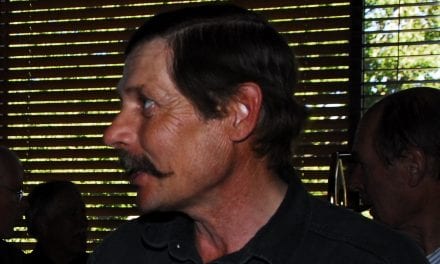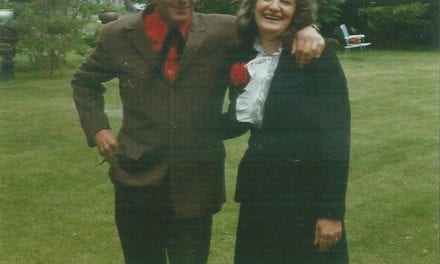SH: So, after that summer what went on in your world?
Ed: Well, you are always trying for different things to enhance your training and of course your chance of getting a full time job. So I did backcountry for the summer, and I was living in town so they put me into sort of Operations for the fall. Then that winter I was one of the guys picked to work on avalanche control at Marmot Basin. So there was myself, and John Niddrie, and Darro Stinson was in charge, and Dave Carnell was the GT-03 assigned up there, so there was the four of us.
This is the time, a lot of people won’t know now, but in those days, Parks Canada did all the avalanche control in the mountain park ski areas; Sunshine, Lake Louise, Norquay and Marmot. All the avalanche control was done by the Warden Service, and it was a great training opportunity to get people involved in avalanche control and avalanche safety. I did that job for the winter and of course once again, there were always competitions being run for full time work. So that winter I competed again for a GT-03 full time position. When the list comes out of course, if you’ve ever competed for something like that where they form eligible lists, you’re always sitting there wondering where you are going to be. So, the list comes out and they made the list to ten and I’m not on it. Finally, the letter comes, because the list always leaks out before the letters come….and the letter comes to me and I’m eleventh. I’m on the edge of getting in. There’s people like Bette Beswick in the top ten I think Al MacDonald might have been on that same list. So you are just on the cusp and you’re disappointed of course, but you have faith that there will be more jobs come open and they’ll extend the list past the ten. For me, that’s exactly what happened.
I finished my winter at Marmot Basin and then I was moved into Frontcountry Operations for that summer and enough jobs became vacant that they extended the list to I believe fifteen. That summer I was offered my first full time position in Elk Island.
SH: Boy Ed, you moved around. (Tape 29:09)
Ed: Yes, I was fortunate I had a chance to work in a few different parks and work out of a few different stations as well.
SH:: So your first full time position in Elk Island ….. what year was that?
Ed: That would have been 1983. I moved in the fall of 1983. I moved out to … it was totally different. I think people that have been trained in the mountains want to stay in the mountains. They are big parks, they’ve got the backcountry, they’ve got the cabins, there’s lots of stuff going on and I have to say that when I got offered Elk Island, I wasn’t thrilled that I was going to Elk Island, but I wanted a full time job. I moved out there probably reluctantly, and they moved me into a station called Oster. It’s on the west side of Elk Island Park, inside the park so you’re surrounded by fence. I’d get up in the morning and there would be bison standing outside, in front of my house. I have to say that I was glad to have the full-time job. Dave Gilbride had come about the same time as I had from Jasper, and there were fellows like George Lukiwski, that was in charge of law enforcement, there was Jack Willman, who was the Chief of the day. Chuck Blythe was sort of the Assistant Chief and the head sort of science guy there.
The way Elk Island worked was more based on science. They were into research and there was very little operational side at the time, and that made it hard for me to adjust. I was given responsibilities for looking after the trails, getting contracts signed. We brought in the Canadian Ski Patrol group to patrol our trails in the winter as a volunteer group. I was responsible for fires in the park, which you don’t really think of much in terms of fires at Elk Island, but we burned a lot of ground there when I was there. So my first year was kind of up and down. I was missing the mountains. I had my job, and I had a house to live in. My girlfriend at the time was living in Edmonton so that was okay. But I really wanted to go back. I was probably a tough employee to have. I butted heads with Jack and Chuck in the first year on stuff and I had to reflect on that. I needed to grow up and accept where I was and what I was doing, and fully engage in the work that was there. Once I wrapped my brain around that everything started to go a lot better. I’m still good friends with Jack to this day.
It was a good … once you start to realize what they do in that park … I think it’s 194 square kilometers and it is totally fenced. It was nicknamed ‘The Farm’ by everybody. But, when you get in there and start working with bison professionally, rounding them up and putting them through squeezes, working with the vets from the federal government, taking samples, all of that sort of stuff, it’s a great place to work. And it’s not just bison, in those days we managed elk, we’d be shipping elk out to re-establish herds throughout western Canada with other provincial agencies. They would request elk and we would pull them in, de-antler the bulls so that they couldn’t kill each other, and we could ship them. It was a lot of fun. I was there for three years.
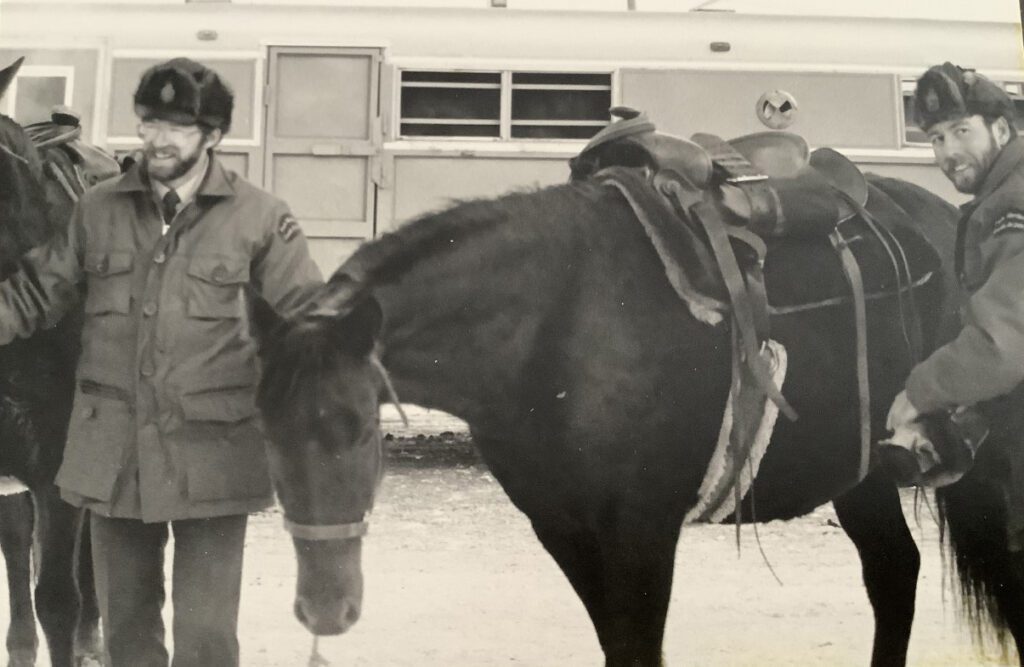
Dave Gilbride and Ed Abbott

Ed Abbott and Wes Bradford
Participation in the 1985 Grey Cub Parade in Edmonton as part of the Canadian National Park Centennial 1885-1985.
SH: So that takes us to the late or mid ‘80s correct?
Ed: Yes, that was 1986. There was kind of a rule that if you wanted to lateral around, the Chiefs of the day, I think they sort of had an agreement amongst themselves that somebody had to stick it out for a couple of years, before they’d just keep moving people, unless it was a promotion of course. But if you just wanted a lateral transfer you had to put in some time and give the park you were in a chance. I’m kind of glad that rule was there, and I took advantage of that and started to really enjoy Elk Island, but I still wanted to get back to the mountains.

985 Centennial Climbing Expedition
Back row: John Nylund (Banff Barn Boss); Frank Burstrom (Rev/Glacier); Peter Deering (Gros Morne); Ed Abbott (Elk Island); Ron Tessolini (Banff); Darro Stinson (Jasper); Brent Kozachenko (Waterton)
Front Row: Clair Israelson (Banff); Dale Loewen (Banff); Hans Fuhrer (Kootenay); Tom Elliot (Yoho); Eric Dafoe (Rev/Glacier); Willi Pfisterer (Jasper). Missing from photo: Don Mickle, Tim Auger, Gaby Fortin and 30 head of patrol horses.
In 1986, my third year at Elk Island, I put in a request for a lateral transfer back to Jasper. I was fortunate enough that Don Dumpleton the Chief, must have seen something in me, so he offered me a lateral transfer back and I came back into Jasper in August of 1986.
SH: And you went into town then?
Ed: Well, they didn’t really have a place for me to stay so I was fortunate enough that I had friends that I could crash with and I found a place to stay and they put me back into the backcountry. I was out in the Moosehorn District on the eastern side of Jasper. Access is either through the Willow Creek District or you can ride on the trail that starts out on the Celestine fire road and you can ride in sort of parallel to the railway tracks but up the slope, and then turn up the slope and go into the Moosehorn District.
It was a popular hunting place along the boundary. There were two cabins; the Moosehorn, which was low down and then there was Wolf Pass which was in the upper parts in an area called ‘The Notch’. It’s called the notch because the Park Boundary sort of went into a big notch, or I should say the Province went in a notch into the park. So you’d ride up a drainage and when you looked up above you, you were looking at the boundary of the park, up above you. Then the trail would cut up and you would be inside the park. It’s kind of hard to describe but it was very popular for sheep and elk hunting. So I was out there for the summer, doing the standard deeds, looking after the cabins and getting the trails open. I didn’t get out there til mid to late August, and then sheep season had started so I was pretty much focused on boundary patrol up around the notch area. In this district I did ten and four, so I’d go in for ten days and I’d come out for four. I did that through to the end of October.
After that I came back to Jasper, and they put me into General Operations and they moved me into Athabasca Falls. There was a trailer at Athabasca Falls so I moved into that trailer. In the spring of 1987, they moved me up to Maligne Lake. I lived up there until the fall, I guess it was December of 1989. That was a lot of fun. I met a lot of different people and got to try different things …. Track-setting, winter with snow study plots, traveling in the Bald Hills, trying to add data to the avalanche forecasting, which would be going out on a daily basis, and of course the lake in the summer is hugely popular with fisherman, anglers and of course the main business up there, Maligne Tours, and their boat tours.
SH: That’s a nice spot to spend the summer
Ed: Yes, it was good. My better half, Cheryl was now living with me. She managed to get a job working at Maligne Tours, so we got to know the staff at Maligne tours fairly well. It’s pretty hard not to when you’re the warden and they’re the business and really the only group of people up there so there are some friendships that we maintain to this day from being up there.
Every time I go to a place, I always try to make improvements. When I moved up there, Lawrence Baraniuk was the district warden before, and he moved out and I moved in. They just had a new office and garage building built up at the station; garage bays and stuff like that. My next challenge was I got a boat dock built up there. We were beaching our boats on the gravel shoreline and there was no dock, so I put in a project to get funding and we actually got a legitimate dock built for our boats up there. That was my one thing that I got done while I was up there for the three years.
SH: That would be a different spot to live year-round, like in the winter.
Ed: Winter, I didn’t spend all my time up there. When you’ve got a warden who lives up there you do your chores in the morning. You check your generators and make sure you’ve got power, and that sort of stuff, and if you have track-setting to do, which the wardens used to do at the time, you would track-set the trails, but the rest of the time you’d hop in your vehicle and drive down and see if there was project work that they could assign you down in town. I didn’t languish up at the lake in the wintertime. Summer you were busy; you were pretty much out on the lake all the time and we had horses as well so we could ride up into the Bald Hills and go up there and have a look around. It was a fun place to live but once again, it’s fun, but I like to be challenged so after three years I was ready to move out and move down into the main part of the park operations centre. That’s kind of what happened … I stayed til December of ‘89 and asked if I could move into town and they opened up Snaring Warden Station. Brian Wallace had just moved out, so in December of 1989 I moved down to Snaring Warden Station which was about 25 kilometres outside of town in Jasper.
SH: Boy you did the station world in Jasper Ed. I’m impressed.
Ed: Yes, I saw most of them at one point. When I got moved down, they got a guy that had a few years of experience, so I moved into Operations and that was being run by Mike Briggs as Assistant Chief and Murray Hindle who was the next in line. So I moved into Operations; Campground patrols. They made me the exhibit guy and the court warden. So, for the next number of years, probably until about 1993 I did the court warden job and I worked with Prosecutors, RCMP, the local Justice of the Peace, made sure all the files were up for going to court, that documents were signed and the files were built. Whenever there was poachings or investigations, I would go in and made sure that all of our kits for doing investigations were all kept up to snuff and everything was behind my desk in a locked room, so I had responsibility.
Exhibits when they were seized, I would move them from the lockers into the exhibit room, keep track of the chain of control for all of that. I did that for close to three or four years.
SH: So now we are in about 1992.
Ed: We can jump ahead. In 1993 they were starting to expand the Warden Service. You may not remember but in the early 90s they had Program Review 1 and Program Review 2. This is when a lot of people actually got let go with “buy outs.” Some people in the Warden Service but a lot of people that were impacted were in other departments. Trades, Visitor Service, Communications, all of those people. A lot of them took a bit of a downsizing, but at the same time the Warden Service was actually gaining positions. That caused a bit of heartache between us and other departments. It was at that time that the Chiefs of the day wanted to have more formal backcountry management. So over the winter of ’92 into ’93 they ran competitions, for backcountry managers for all of the parks. Jasper kind of had one already, they had Brian Wallace and I’m not sure who the warden was in Banff at the time, but moving along, they basically had the competitions, and I was awarded the backcountry manager’s job in Kootenay. This is when Kootenay was still just “Kootenay”. So, in the fall of 1993 Cheryl and I moved down to Kootenay Crossing, we moved into one of the houses. That’s where Perry Jacobson, the Chief of Kootenay, wanted the backcountry to be focused out of. That’s where the horses were kept. He was trying to keep stations like Kootenay Crossing relevant at the time. In the fall of 1993 Cheryl and I moved down and we took up residence at the house.
The unfortunate thing about living at a station like Kootenay Crossing when you’re a backcountry manager is you can’t communicate with anybody. All we had was radio, we had no phones, we had no computers, and you were about a 40-minute drive to get down to the office.
I would get up in the morning and do my routines: do the weather, if it was summertime I’d check on the horses and throw some feed out, check the generators and then I’d hop in my warden truck and drive down to the office, which was the old Superintendent’s house, overlooking the hot pools down towards Radium. I’d go down there and do my work and reach out to other backcountry managers. At the time I think it was Doug Eastcott acting in Banff, there was myself in Kootenay, and about a year later Terry Winkler got offered Yoho. Perry Jacobson was the manager of all of the backcountry guys, so he was our lead for managing backcountry issues and for exchange of information. That’s when we started, we were being directed to come up with a fee schedule for backcountry use. The Minister had already come out with the basic philosophy “if you use it you pay for it, and if you don’t use it you don’t pay.” Up until then backcountry camping, with the exception of grazing fees for horse parties, basically backcountry use had been free. You were expected to register to go out, but the permitting was free. That ended I believe in 1994, when the group of us, led by Perry came up with the ‘Wilderness Pass’.
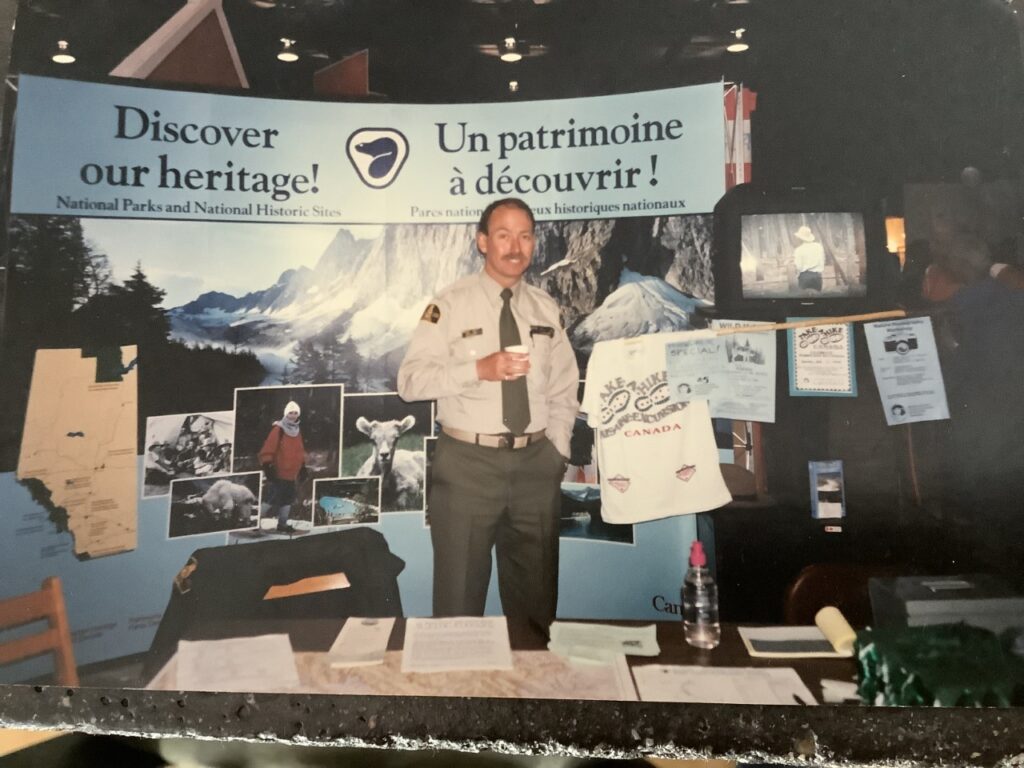
Ed Abbott at a Trade Show representing Parks Canada
You start to realize how many things are different in all of the Parks. Yoho and Kootenay, and I don’t mean this is a disparaging way, were kind of seen a bit as sleepy parks. They weren’t as busy as Banff and Jasper. Quite often people who went to those parks, they stayed in those parks. They never moved again and did their careers there. When I came down, I wasn’t sure about the park, but it turned out it was a great opportunity. I liked working with all of the staff there. We had John Niddrie, Brian Sheehan, Randy Chisholm, Byron Irons just a whole bunch of good guys. Alan Dibb was the wildlife guy … we did lots of good stuff. Hans Fuhrer, Hansy, was our public safety guy. But we were working in this little tiny office, so at the same time we were growing, but we were sitting on each other’s laps almost in this building, so the park had decided that they were going to convert their old bunkhouse into an operational office.
So there was a lot of change going on at this time. The backcountry guys were bringing in social scientists. That was the Chiefs led by Perry saying we need to understand our backcountry users. We don’t know much about them. So he got one of the first social science people working for Parks Canada in the field. There were social science people in regional offices but not in the field. We were making a lot of changes, going along at that period and of course on top of all of that, the thing that was looming was the establishment of the Parks Canada Agency and they were looking at ways to reduce the number of managers and I think everybody knows that’s when this led to the formation of the field unit … the LLYK, the Lake Louise, Yoho, Kootenay Field Unit.
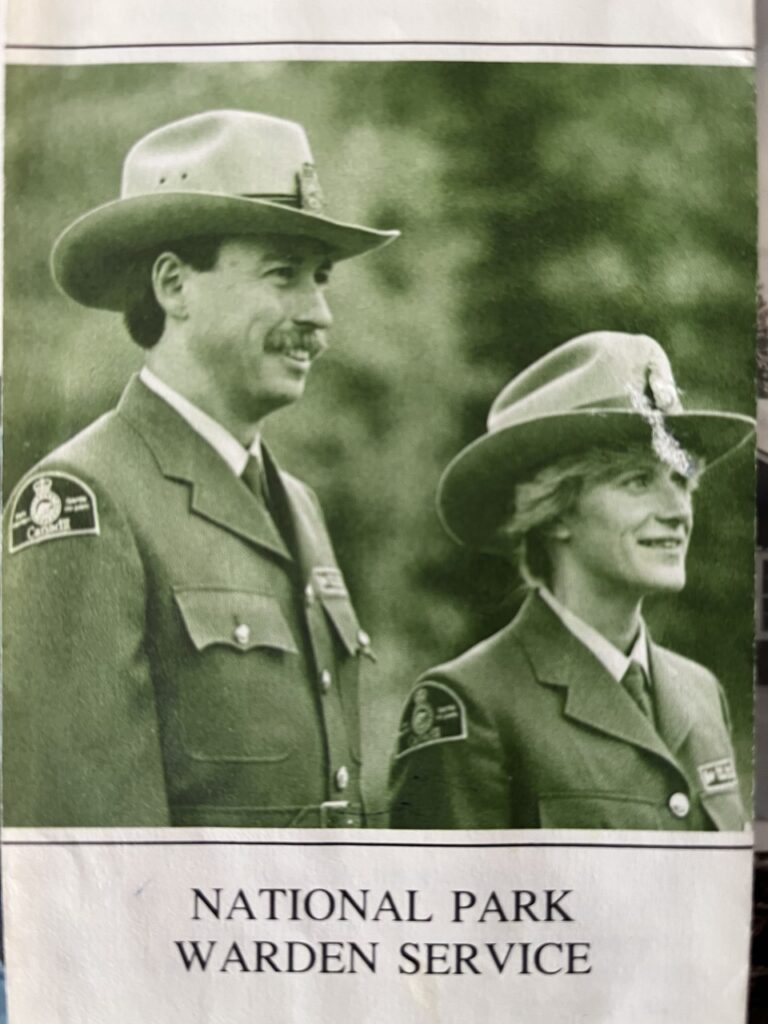
Ed Abbott and Olive Dodd, Recruitment Poster.
So all of these things were bubbling at the same time. It was changing. It was uncomfortable at times because you didn’t know what was going to shake down.
